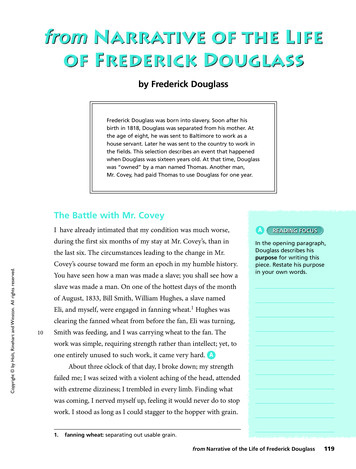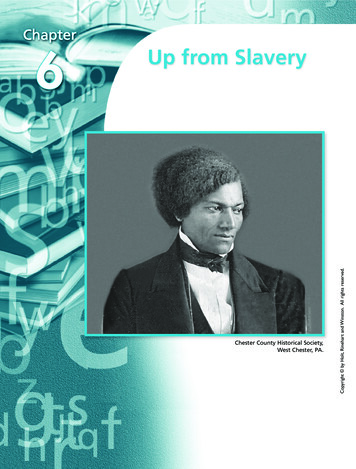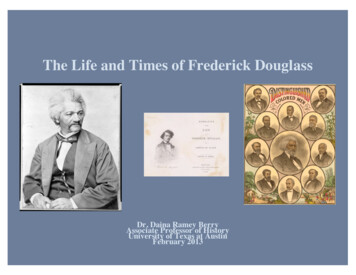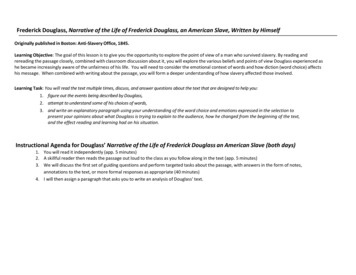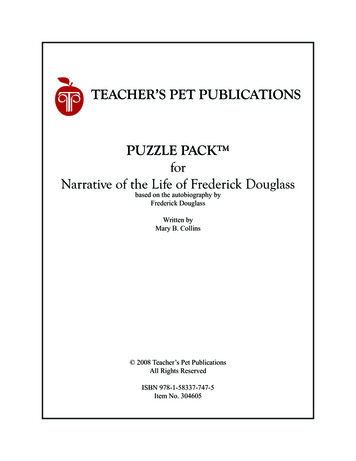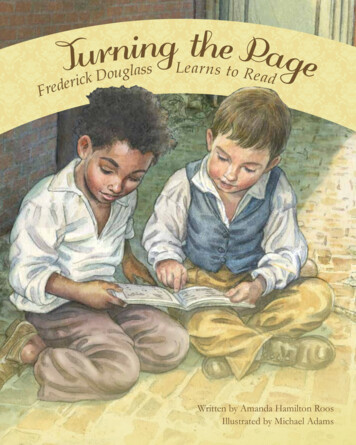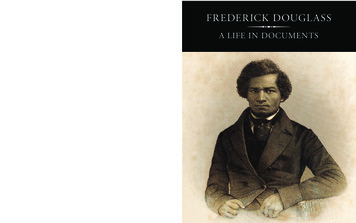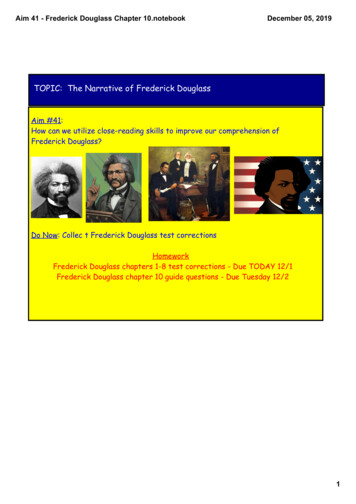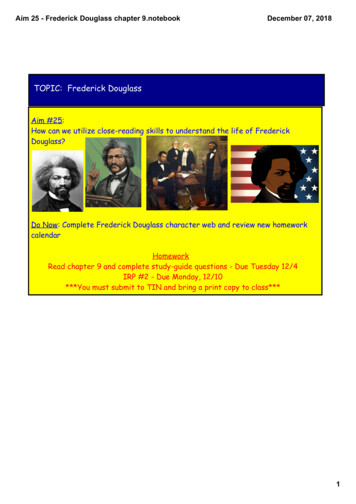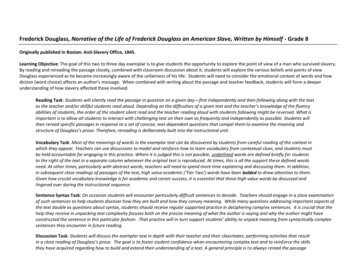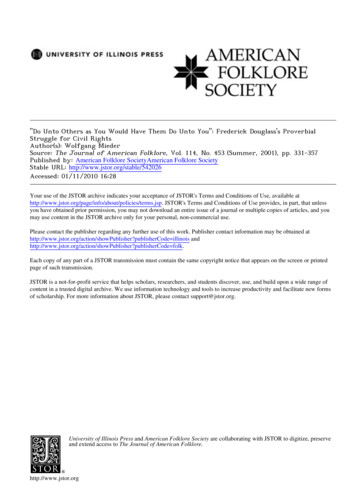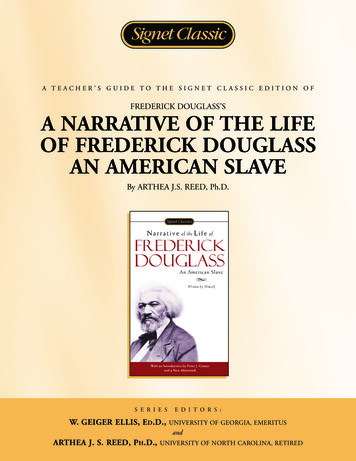
Transcription
A TEACHER’S GUIDE TO THE SIGNET CLASSIC EDITION OFFREDERICK DOUGLASS’SA NARRATIVE OF THE LIFEOF FREDERICK DOUGLASSAN AMERICAN SLAVEBy ARTHEA J.S. REED, Ph.D.S E R I E SW. GEIGER ELLIS, ED.D.,E D I T O R S :UNIVERSITY OF GEORGIA, EMERITUSandARTHEA J. S. REED, PH.D.,UNIVERSITY OF NORTH CAROLINA, RETIRED
A Teacher’s Guide to the Signet Classic Edition of Frederick Douglass’s A Narrative of the Life of Frederick Douglass an American Slave2INTRODUCTIONFrederick Douglass’s slave narrative is readily accessible to high school students. It is short (slightly more than 120 pages),easy to read and understand, and filled with warmth and wisdom. In addition it presents a vivid picture of a horrifyingperiod of American history that far too few students understand. Students may read about the institution of slavery inhistory textbooks, some of which attempt to show the cruel inhumanity of many slave owners, but no textbook allowsstudents to see and feel the fear, pain, and hate. Douglass’s narrative of his life as a slave lets readers feel the fear he has asa small child separated from his mother, allows us to experience with him the pain inflicted by undeserved whippings andweakness caused by too little food and too much physical exertion, and helps us understand not only the hate of the slavefor the master but the sickness of hate that allowed human beings to keep other human beings as chattel.Frederick Douglass not only provides students with an understanding of the horrors of slavery but also helps studentsunderstand how they can overcome adversity. Although a slave, Douglass’s mind was never enslaved. He who was deniedany formal education and deprived of books and paper writes eloquently about the importance of knowledge. He tellsreaders that the only way men can be enslaved is by remaining ignorant. He also writes that learning is “the pathway fromslavery to freedom” (p. 49). Perhaps, it takes someone who was denied the right to learn to teach today’s students theimportance of the education they take for granted.Narrative of the Life of Frederick Douglass is appropriate reading for many grade levels and subjects. Although it can beread and understood as early as middle school, the values examined in the book may be too mature for most middle schoolstudents. However, it is certainly appropriate to share parts of the book, perhaps reading it aloud, to students as early asseventh grade. By high school the majority of students will be able to read and understand the narrative. One of thewonderful elements of the work is that its content is mature, making it appropriate for the most able students, while itseasy-reading level makes it accessible to students who have difficulty reading. In addition to the wide range of studentsfor whom it is appropriate, it can be taught in many subject areas. In United States history it allows students to study aprimary source. In English it can be studied as an autobiographical work. It is also appropriate in courses such aspsychology, sociology, and anthropology. At the college level it can be analyzed in the above classes and also successfullyused in education courses as well as general seminar courses in which students examine and discuss important issues.Because this small book is appropriate in so many classes, this guide will attempt to show how it can be utilized in U.S.history, English, and education courses. When questions and activities are appropriate for other subject areas as well, thesewill be listed parenthetically. As with the other study guides in this series, prereading, during reading, and after readingquestions and activities are suggested. Those questions and activities which are only appropriate for mature students arestarred (*). In addition, a bibliography suggests how this narrative can be incorporated with other books in units on suchtopics as the Civil War, African Americans from slavery to the 20th century, and slavery and freedom.OVERVIEWTIMELINE OF THE LIFE OF FREDERICK DOUGLASS(All dates are approximate since slaves were kept ignorant of the concept of time or dates.)1818Frederick Bailey (Douglass) born in Tuckahoe, near Hillsborough, Maryland. Mother—Harriet Bailey,a slave; father—a white man, perhaps the master. Separated from mother in infancy.1824Harriet Bailey dies; seen only by son four or five times when she’d travel twelve miles by foot at night.1817-1825Lived on the “Great House Farm” plantation of Colonel Edward Lloyd; master was Captain Anthony,Colonel Lloyd’s clerk.1825Moved to Baltimore, Maryland, home of Mr. Hugh Auld, brother of Colonel Lloyd’s son-in-law,Captain Thomas Auld.1825Mrs. Sophia Auld, new mistress, begins to teach Frederick to read; Mr. Auld finds out and forbids it,calling it “unlawful” and “unsafe.”1825-1832Lives with Aulds; continues to learn to read and write, often bribing the poor white children to help him.
A Teacher’s Guide to the Signet Classic Edition of Frederick Douglass’s A Narrative of the Life of Frederick Douglass an American Slave31828Returns to Colonel Lloyd’s plantation after death of Captain Anthony and his youngest son Richardso that property, including horses and slaves, can be divided between two surviving children, Mrs.Lucretia and Master Andrew; falls to the portion of Mrs. Lucretia and is returned to Baltimore.1829Reads “The Columbian Orator,” giving words to his feelings about slavery; learns the meaning of theword “abolition”; meets two kind Irishmen who advise him to run away to the north; “from that timeon I resolved to run away” (p. 57).(The following dates are more accurate since Frederick has learned to read and understands dates.)March, 1832Mrs. Lucretia and Master Andrew have both died; Master Thomas Auld, Lucretia’s husband, remarriesand has a misunderstanding with Master Hugh. As punishment of Hugh, Frederick goes to live withMaster Thomas in St. Michael’s, Maryland. Master Thomas is not as good a master; he feeds his slavesvery little.Jan. 1, 1833Sent to live with Mr. Covey who has the reputation “for breaking young slaves” (p. 70); Frederick isfrequently whipped. He writes, “Mr. Covey succeeded in breaking me. I was broken in body, soul, andspirit. My natural elasticity was crushed, my intellect languished, the disposition to read departed, thecheerful spark that lingered about my eye died; the dark night of slavery closed in upon me; and beholda man transformed into a brute!” (p. 75).Aug. 1833Frederick becomes ill in the fields; Mr. Covey whips him. Frederick runs away from Mr. Covey andfiles a complaint with Master Auld which is rejected. When Frederick returns to Mr. Covey’s he vowsto fight which he does; Mr. Covey’s treatment toward him begins to change; Frederick vows that henever will be whipped again. “This battle with Mr. Covey. rekindled the few expiring embers offreedom, and revived within me a sense of my own manhood” (p. 82).Jan. 1, 1834Moved to home of Mr. William Freeland, three miles from St. Michael’s. Mr. Freeland was “aneducated southern gentleman” and much kinder to the slaves. Frederick begins a Sabbath school forslaves; if they were caught they would be whipped, but they wanted to learn to read and write.Jan. 1835Mr. Freeland again hires Frederick from his master. Frederick and several other slaves plot an escapebut are discovered and sent to jail. For a reason unknown to Frederick, Master Thomas Auld decidesto send him back to Baltimore to Hugh Auld.1835Sent to learn the trade of caulking at a shipyard; severely injured in fight with white carpenters; Mr.Hugh Auld takes Frederick to work in shipyard where he is foreman; Frederick learns quickly and issoon earning wages which he must turn over to Master Hugh Auld.Spring 1838Frederick applies to Master Thomas to allow him to hire his time; Thomas refuses; however, later Hughagrees making a deal which guarantees him more money. Frederick agrees to the plan since it is the onlyway he can earn money to escape. When Frederick goes out of the city on work without permission,Master Hugh tells him to “bring my tools and clothing home forthwith” (p. 109). This makes Frederickmore committed to find a way to escape.Sept. 3, 1838Frederick escapes to New York; he does not reveal the means in his narrative, stating that it couldembarrass some and keep others from escaping; he is helped by Mr. David Ruggles who housesFrederick in his boarding house and helps him get Anna Murray, a free black woman, to New York.Sept. 15, 1838Anna Murray and Frederick Johnson (name changed from Frederick Bailey) marry; this is particularlyimportant since slaves were not permitted to marry; they leave for New Bedford. In New Bedford thecouple is helped by Mr. and Mrs. Nathan Johnson. Frederick asks the Johnsons to help him pick a newname; Mr. Johnson who is reading “Lady of the Lake” selects Douglass.Aug. 11, 1841At the anti-slavery convention at Nantucket Mr. William C. Coffin urges Frederick Douglass to speak.Douglass writes, “It was a severe cross, and I took it up reluctantly. The truth was, I felt myself a slave,and the idea of speaking to white people weighed me down” (p. 119).
A Teacher’s Guide to the Signet Classic Edition of Frederick Douglass’s A Narrative of the Life of Frederick Douglass an American Slave4BEFORE READINGENGLISHBe sure the students understand the terms nonfiction, autobiography, and narrative.The narrative is basically chronological. However, he does digress in some chapters. Therefore, it might be helpful toduplicate the timeline above so students can refer to it as they read.Throughout the narrative Douglass discusses many ironies. Discuss the meaning of the word irony and provide some examples.Ask students to write about a time they were not allowed to do something and how it made them feel.Have the students write in their journals their impressions about what life would be like as a slave.Introduce and define the words: slavery, abolition, abolitionist, and chattel.Read a fictional account of slavery such as Belinda Hurmence’s A Girl Called Boy and Tancy or Barbara Smucker’sRunaway to Freedom: A Story of the Underground Railroad or Uncle Tom’s Cabin by Harriet Beecher Stowe.Read the first chapter aloud to the class. Discuss it.HISTORYDiscuss the concept of “primary source.” Read one or more secondary sources about slaves such as Virginia Hamilton’sAnthony Burns: The Defeat and Triumph of a Fugitive Slave, Arna Bontemp’s Great Slave Narratives,To Be a Slave byJulius Lester or Black Foremothers by Dorothy Sterling.Place the narrative in its historical context or ask the students to do so. Discuss what was occurring in the U.S. between1818, the birth of Douglass, and 1845, the publication of his narrative. It might be useful to place it on a timeline alongwith other historical events occurring at the same time.EDUCATIONHave the students write about and discuss how they would be different if they could not read or write.Discuss the concept: “there can be no freedom without education.”Examine education during the colonial period prior to the Revolution. How did education differ by region in the colonies:New England, the middle Atlantic states, and the southern states?WHILE READINGThis section of the teacher’s guide is divided by chapters, which parallel the chapters of the narrative. Further, it issubdivided by questions, quotations, and activities, many of which can be used across subject areas. Most of the questions,quotations, and activities can be used in English, history, and/or education classes. However, when one is moreappropriate for one subject area than another, the subject area is indicated parenthetically. Questions are designed to helpstudents comprehend the narrative and move beyond comprehension to analysis and evaluation. Quotations can be usedas discussion starters or as writing prompts for response journals. Activities are designed for small groups to help studentsdeal with the concepts in a more personal way.The response journal technique is appropriate for all three subject areas. In it students respond to the quotations inwriting. Teachers should encourage them to respond in a variety of increasingly complex ways. This will allow students todevelop thinking and writing skills at the analytical and evaluative levels.
A Teacher’s Guide to the Signet Classic Edition of Frederick Douglass’s A Narrative of the Life of Frederick Douglass an American Slave5LEVELS OF STUDENT RESPONSEA. Engaging: The articulation of the reader’s emotional reaction or level of involvement, from “This is BOR-ING,” to “Icouldn’t put it down,” are called engaging. The first is called lack of engagement; the second engagement. However, thereader’s articulation of her or his level of engagement with the text may be the first step in responding to it. For example,tell students, “Write about how the chapter makes you feel.”B. Describing: Restating or reproducing information that is provided in the text requires selecting some important aspect ofthe text and is often the next level of response. For example, tell students, “Select any quotation from this chapter, writeabout what you think it means.”C. Conceiving: Making statements about meaning or inferring from important aspects of the text. For example, tell students,“Write about this quote, discuss not only what it means to you, but what it means in relationship to Frederick’s life as a slave.”D. Explaining: Explaining why the characters do what they do; examining their motivation. For example, ask students to explainwhy learning to read was so important to Frederick. Ask them, “What did he believe the ability to read would give him?”E. Connecting: The reader connects her or his own experiences with the text. As in all responding to text, connecting is arecurrent movement between the text and one’s experiences, knowledge, and attitudes. The reader may first recall a similarexperience, next elaborate on that experience, next apply the experience to the text, later use the text to reflect on her orhis own experience, and finally, interpret the text and the experience. For example, ask the students to write about a timewhen they felt like they were trapped. Now, they might write or discuss how this experience would have been different ifthey saw little hope of escaping. Next, they might write or discuss what they would try to do to escape. Finally, they mightput themselves in Frederick’s place: what would they do to attempt to become free?F.Interpreting: The reader uses all the reactions above to interpret an overall theme or meaning of the text. For example, askquestions such as: “Why did Frederick write this narrative? What was the danger in writing it? When did Frederickconceive that freedom was a possibility?”G. Judging: The reader makes judgments about the text: the truth of the text, the importance of the text, the quality of thetext, etc. For example, ask student questions such as: “Why is this narrative still read today? Are there any lessons in it foryou? Any lessons for the country?”CHAPTERS 1-5CHAPTER ISets the scene; Frederick tells us some of his early life and begins to explain life on the plantation.QUESTIONSWhy is Frederick not sure when he was born?What is Frederick’s last name at birth?Why would slaveholders want to keep a slave ignorant of such a simple thing as the date of his birth? (Education)Who were Frederick’s mother and father?Why does Frederick make the point that a slaveholder who has fathered a child is likely to be tougher on that child?Why does Frederick only rarely see his mother?Is Frederick’s relationship with his mother typical of other slave children?What is the role of the overseer on the plantation?What is the relationship of the slaveholder to the overseer to the slave on the plantation? (History)What do we learn about Plummer, the overseer?
A Teacher’s Guide to the Signet Classic Edition of Frederick Douglass’s A Narrative of the Life of Frederick Douglass an American Slave6Who is Frederick’s first master?Why does Frederick tell the story of Lloyd’s Ned?QUOTATIONS“By far the larger part of the slaves know as little of their ages as horses know of theirs, and it is the wish of most mastersto keep their slaves thus ignorant” (p. 21). [The intentional ignorance of slaves plays an important role in Frederick’sunderstanding of the system.] (Education)“He was a cruel man, hardened by a long life of slaveholding” (p. 24). [This is an important point that Frederick willcontinue to make throughout the narrative.] (History)“It was the blood-stained gate, the entrance to hell of slavery, through which I was about to pass” (p. 25).ACTIVITIESChart the relationship of slaveholder to overseer to slave on chart paper. (History/Anthropology)Discuss life on the plantation for slaveholder, overseer, and slave.CHAPTER IIDescribes the plantation system of Colonel Lloyd; discusses the daily existence of slaves on the plantation.QUESTIONSWho were the family members of Frederick’s master Colonel Edward Lloyd?What is the relationship of Colonel Lloyd to Frederick’s master?Was there a pecking order among slaves? Explain.Why would a slave whose life on a plantation was very bad fear being sold to a slave-trader?Why was Severe an appropriate name for the overseer? (English)Why is it difficult to find copies of slave songs?Why does Frederick suggest that slaves sing out of sorrow rather than out of joy?QUOTES“The same traits of character might be seen in Colonel Lloyd’s slaves, as are seen in the slaves of the political parties” (p.30). (History) *“Crying for joy, and singing for joy, were alike uncommon to me while in the jaws of slavery” (p. 32).ACTIVITIESDraw a diagram of the holdings (including plantations and slaves) of Colonel Lloyd. (History/Sociology)Discuss with your group what you would likely possess if you were an adult slave on Colonel Lloyd’s plantation. Nowdiscuss what you would possess if you were a child slave. (Anthropology)Write a diary and then make a chart of a day in the life of a slave. (Anthropology/Sociology)Go to the library and find some songs sung by slaves. Discuss the meaning of these songs and examine if they were likelyto be sung because of sorrow as suggested by Frederick. (English)
A Teacher’s Guide to the Signet Classic Edition of Frederick Douglass’s A Narrative of the Life of Frederick Douglass an American Slave7CHAPTER IIIRelates several anecdotes that tell readers more about plantation life and the thinking of slaves.QUESTIONSHow did Colonel Lloyd keep the slave boys from taking his fruit?Why was it particularly difficult to be the slaves in charge of Colonel Lloyd’s horses?What is ironic about Colonel Lloyd’s treatment of his horses compared to the treatment of his slaves? (English) *What happened to the slave who told Colonel Lloyd the truth about his master?What is a maxim? (English)QUOTESSlave maxim: “a still tongue makes a wise head” (p. 36). (English)ACTIVITIESAdd to your diagram of Colonel Lloyd’s plantation holdings. (History/Anthropology)Discuss the prejudice that existed among slaves from different plantations. Examine the irony of this prejudice. (English)CHAPTER IVTells readers more about overseers and relates incidents of slave murders.QUESTIONSWhy is Mr. Austin Gore a “first-rate overseer”? What is the irony of this description of him? What is ironic about hisname? (English)What reason does Mr. Gore give for killing Demby the slave?What other examples does Frederick give of his statement “that killing a slave, or any colored person,. is not treated asa crime, either by the courts or the community” (p. 41)? (History)*QUOTESMaxim laid down by slaveholders: “It is better that a dozen slaves suffer under the lash, than that the overseer should beconvicted, in the presence of the slaves, of having been at fault” (p. 38).“To be accused was to be convicted, and to be convicted was to be punished” (pp. 38-39). [Another important point thatcontinues throughout the narrative.] (History)“He dealt sparingly with his words, and bountifully with his whip, never using the former where the latter would answeras well” (p. 39).ACTIVITIESDiscuss the system of justice on the plantation. How does this system differ from the system developed in the early daysof the Union? (History)Go to the library and do research on the U.S. justice system and people of color. Present your findings to the class. (History) *
A Teacher’s Guide to the Signet Classic Edition of Frederick Douglass’s A Narrative of the Life of Frederick Douglass an American Slave8Read To Kill a Mockingbird (Lee) or The Autobiography of Miss Jane Pittman (Gaines); discuss if and how the U.S. justicesystem changed in its treatment of people of color. (English) *CHAPTER VExamines Frederick’s life as a slave child and discusses his leaving the plantation.QUESTIONSWhat was life like for Frederick on the plantation?Why was Frederick so happy to be leaving the plantation?Why did he particularly want to go to Baltimore?What relationship did his new master have to his old master?Why did Frederick, who was seven or eight, not know the month or year of his sailing?What were Frederick’s initial impressions of his new mistress, Mrs. Sophia Auld?QUOTES“I may be deemed superstitious, and even egotistical, in regarding this event as a special interposition of divine Providencein my favor” (p. 47).ACTIVITIESDraw pictures of slave children in summer and in winter. (Anthropology)On a map plot the route that Frederick followed to get to Baltimore. (History/Geography)CHAPTERS 6-10CHAPTER VIDiscusses learning to read and explains its importance.QUESTIONSTo what does Frederick attribute the kindness of Mrs. Auld?What, according to Frederick, changes her?Why is Mr. Auld angry when he finds that Mrs. Auld is teaching Frederick his letters?Why does Frederick call Mr. Auld’s forbidding his learning how to read “invaluable instruction” (p. 49)? (Education) *Why does inability to read keep men enslaved according to Frederick and to Mr. Auld? (Education)What does Frederick hope to gain by learning how to read?Who teaches Frederick why black men are not taught to read?Why is this lesson so important to him?Why is the life of a city slave so much better than the life of a plantation slave?Why does Frederick relate the story of the slaves Henrietta and Mary? (English)
A Teacher’s Guide to the Signet Classic Edition of Frederick Douglass’s A Narrative of the Life of Frederick Douglass an American Slave9QUOTES“If you teach that nigger (speaking of myself ) how to read, there would be no keeping him. It would forever unfit him tobe a slave. He would at once become unmanageable, and of no value to his master” (p. 49).“I now understood what had been to me a most perplexing difficulty—to wit, the white man’s power to enslave the blackman. It was a grand achievement, and I prized it highly. From that moment, I understood the pathway from slavery tofreedom” (p. 49). (Education)“In learning to read, I owe almost as much to the bitter opposition of my master, as to the kindly aid of my mistress. Iacknowledge the benefit of both” (p. 50). (Education) *“A city slave is almost a freeman, compared with a slave on the plantation” (p. 50).ACTIVITIESDiscuss the irony of what Mr. Auld taught Frederick when he forbid Mrs. Auld to teach him to read. (English)Conduct a role play of Master Auld, Mistress Auld, and Frederick discussing Frederick’s learning how to read.Go to the library and investigate the education of slaves in the United States. Discuss: Was Frederick’s situation typical?Why? Why not? (History/Education) *Discuss: In education we refer to the school’s ‘hidden curriculum,’ that which is not intentionally taught but is learnedby the students. What are some of the ‘hidden curricula’ in the schools you attended? How does Mr. Auld’s lesson toFrederick relate to the concept of the ‘hidden curriculum?’ (Education) *Examine the concept of reading as equivalent to freedom. (Education) *Discuss how you might use this chapter with a class of middle or high school reluctant readers. (Education) *CHAPTER VIIRelates what Mrs. Auld learned from keeping slaves; how Frederick came to hate slavery and how he learned to write.QUESTIONSHow did Mrs. Auld change and why did she change?What plan did Frederick adopt to learn how to read now that Mrs. Auld was no longer teaching him?Why is it ironic that he bribed the little white boys to teach him to read? (English)What irony does Frederick find in this statement: “It is almost an unpardonable offence to teach slaves to read in thisChristian country.” (p. 54)? *What did Frederick learn from the book “The Columbian Orator”?How does Master Auld’s prediction about Frederick and learning come true?How does Frederick learn the meanings of the words abolition and abolitionist?What do the two Irishmen encourage him to do? Why does he not trust them?How does Frederick learn to write?How does he trick the white boys into teaching him new letters?
A Teacher’s Guide to the Signet Classic Edition of Frederick Douglass’s A Narrative of the Life of Frederick Douglass an American Slave10QUOTES“Slavery soon proved its ability to divest her [Mrs. Auld] of these heavenly qualities. Under its influence, the tender heartbecame stone, and the lamblike disposition gave way to one of tiger-like fierceness” (pp. 52-53).“The first step had been taken. Mistress, in teaching me the alphabet, had given me the inch, and no precaution couldprevent me from taking the ell” (p. 53).“I would at times feel that learning to read had been a curse rather than a blessing. It had given me a view of my wretchedcondition, without the remedy. It opened my eyes to the horrible pit, but to no ladder upon which to get out” (p. 55).(Education) *“White men have been known to encourage slaves to escape, and then, to get the reward, catch them and return them totheir masters” (p. 57).ACTIVITIESDiscuss the concept of learning as a curse rather than a blessing. Frederick makes this comment on page 55. Is it possiblethat he is correct? Readdress this issue after you finish reading the book. (Education) *Write a diary entry of a memory you have about an early reading experience. Discuss how your experience differed from Frederick’s.Write about why learning to read is so important to practicing freedom. Discuss your writing in a small group. Examine thequestion: Did the slave owners understand that learning to read was important to practicing freedom? (English/History)Discuss how you learned how to read and write. How did it differ from the methods used by Frederick?(English/Education)Go to the library to find out how the colonists felt about education. Compare this to how slaveholders felt about theeducation of slaves. Why was education considered essential for white children in New England and illegal for slavechildren in the south? (History/Education) *CHAPTER VIIIDiscussion of slaves as property; plight of old slaves; return to Baltimore.QUESTIONSWhy was Frederick forced to return to the plantation after the death of his master?How was the value of the master’s property determined? How were the slaves valued?Why was the division of property between Mistress Lucretia and Master Andrew so horrifying to the slaves?What happened to Frederick’s grandmother after the deaths of Lucretia and Andrew? How does this anecdote help explainthe value of slaves? How are slaves valued when compared to livestock? [The ironic comparison of slaves to livestock is acontinuous theme of the narrative.]Who owns Frederick by the end of chapter eight?Why is Frederick forced to leave Baltimore?QUOTES“At this moment [valuation of the property], I saw more clearly than ever the brutalizing effects of slavery upon both slaveand slaveholder” (p. 60).“The hearth is desolate. The children, the unconscious children, who once sang and danced in her presence, are gone. Shegropes her way, in the darkness of age, for a drink of water. Instead of the voices of her children, she hears by day themoans of the dove, and by night the screams of the hideous owl. All is gloom. The grave is at the door” (p. 62).
A Teacher’s Guide to the Signet Classic Edition of Frederick Douglass’s A Narrative of the Life of Frederick Douglass an American Slave11ACTIVITIESDiscuss John Greenleaf Whittier’s poem (p. 62). Why does Frederick put this poem in his narrative immediately followingthe anecdote about his grandmother? (English) *Go to the library and find other poems by Whittier. What other poems has he written about slavery? Why does Frederickcall him the slave poet? (English) *Trace the ownership of Frederick from the beginning of the narrative through chapter eight. Explain why he is owned byso many different people. (History/Sociology)CHAPTER IXMoves to St. Michael’s, Maryland, with Master Thomas Auld; the irony of the Christian slaveholder is discussed.QUESTIONSWhy does Frederick now know the date?Who is Frederick’s newest Master?What rule of slaveholding does Master Thomas Auld violate?How did the slaves get food?Why does Frederick say that “adopted slaveholders are the worst”?What, according to Frederick, happens to Master Thomas Auld after his conversion to Christianity? Why?Why does Frederick find irony in the fact that the slaves sabbath school is discontinued? (English/Education) *Why does Frederick let Master Thomas’s horse run away?Again, Frederick compares the treatment of slaves to the treatment of horses. How?How does Master Thomas propose to ‘break’ Frederick?Why is the use of the verb ‘to break’ ironic? *Why was Mr. Covey’s reputation for breaking slaves of great value to him?Why does Frederick suggest that Mr. Covey’s “pious soul” (p.70) adds to “his reputation as a ‘nigger-breaker’” (p. 70)? *QUOTES“After his conversion, he found religious sanction and support for his slaveholding cruelty” (p. 67). [This is an importantpoint that Frederick continues to make throughout the rest of the narrative.]“He would quote this passage of Scripture—’He that
Douglass writes, "It was a severe cross, and I took it up reluctantly. The truth was, I felt myself a slave, and the idea of speaking to white people weighed me down" (p. 119). A Teacher's Guide to the Signet Classic Edition of Frederick Douglass's A Narrative of the Life of Frederick Douglass an American Slave 3
